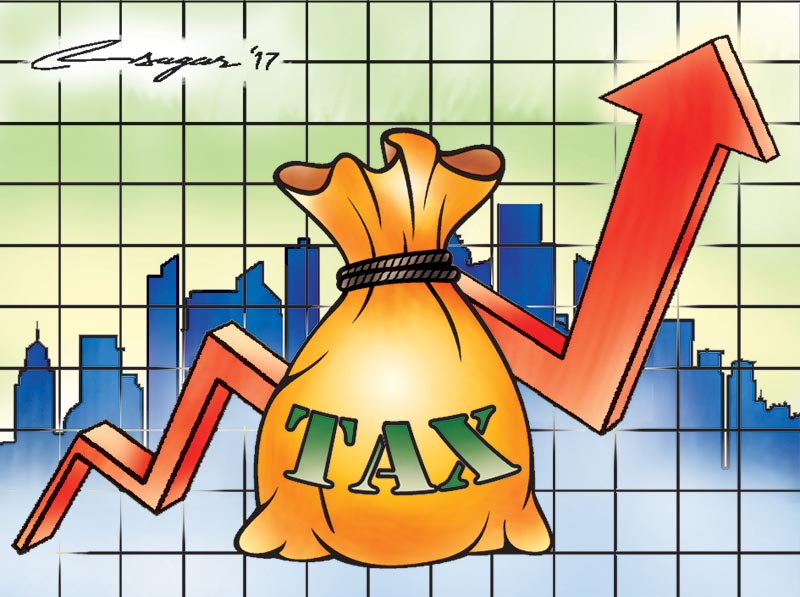Decreasing exports: Reduce tariffs
To minimize the impact of tariff reduction on revenue loss, the process could be staggered-- starting with tariff reduction on items of higher export volume and then gradually moving to others
Nepal’s imports in recent years have seen a steep growth while exports have declined resulting in an alarming trade deficit, about 35% of GDP. The major reason for decline of exports is loss of competitiveness brought on by appreciation of the real exchange rate as well as high production costs. Since Nepal depends on imported raw materials and intermediate goods for most of its manufactured exports and given high import tariffs on them, one way to improve export competitiveness and hence exports is to reduce the tariffs (customs duties). Reducing tariffs would lower cost of production and enhance price competitiveness.
According to trade data from CBS, in FY 2016/17, Nepal’s imports to exports ratio for goods was 12 to 1. For every 1 rupee in exports, Nepal imported 12 rupees worth of goods. This is a cause for concern because for one this is not sustainable, and we as a country are producing fewer goods that can be sold in foreign markets. To reverse this trend, something must be urgently done. While the government has incentives like duty drawback on tariffs and taxes paid on imported raw materials as well as cash incentives on exports, their effectiveness is questionable.
Before discussing the merits of reducing tariffs on imported inputs, it is worth looking at the export incentives that are currently in place. The duty draw back provision allows firms that export goods to get refund on taxes—VAT, import tariffs (customs duties), and excise duties on certain goods-- paid on raw materials. However, this is not a straightforward process; it involves navigating the bureaucracy, and there is a time lag-- meaning firms can only claim refunds after goods are exported and are required to furnish evidence of export. Certain conditions also have to be met. Firms cannot be sure that the tariffs and taxes will be refunded.
Uncertainty over tariff tax refund means that businesses will price their products factoring in the actual cost of the inputs and not lower price in anticipation of future tax rebates. So it may not achieve the intended outcome of lowering the price of exports because initially firms have to pay tariffs and taxes on imported inputs. It is only after that the goods are exported that they are eligible to claim refund. Therefore, the duty drawback provision may not work as intended in promoting exports.
There is also an export promotion scheme that entitles firms exporting certain industrial and agricultural products goods to get 2% of the export value of exports. This has not been effective so it needs to be revised. This scheme has failed to bring about diversification of exportable goods and also failed to spur export to new markets.
One of the main reasons for decline in Nepal’s export is higher cost of production and hence higher price. Lowering tariffs on raw materials reduces the price of raw materials and this translates to lower price of the finished products. Likewise, reduced tariffs on intermediate goods also reduce the cost of production. Taken together, this change in tariff rates would make Nepali goods more competitive in the international market and as a result our exports would grow. In fact, Nepal has some of the highest tariffs on raw materials and intermediate goods in South Asia. To compete with other countries, it needs to lower them.
Tariffs and taxes on imported goods constitute the main source of government revenue. So this proposal would have revenue implication. Sure revenue will decline depending on how much tariffs are reduced but promoting exports should also be an equally important consideration. Manufacturing has been in decline, accounting for about 6% of GDP, and this could provide a shot in the arm. Also, through increased exports jobs will be created in the country. Besides, the suggestion is not to eliminate import tariffs—just reduce them so that it will improve our competitiveness. To minimize the impact on revenue loss, the process could be staggered-- starting with tariff reduction on items of higher export volume and then gradually moving to others. How much tariffs to slash is for the government to decide. It is worth noting that the government has not been able to spend the allocated budget in the past, so a slight drop in revenue will not hurt.
scenario when tariff reduction raw materials and intermediate goods is undesirable is if there are domestic firms producing them. Cheaper imported intermediate goods could hurt domestic firms or could even make it difficult for them to survive if they are infants. However, for most of the manufactured goods that Nepal exports, the raw materials and intermediate goods are imported. So there is no need to worry about the adverse impact on domestic firms producing intermediate goods. A bit of competition could also be beneficial forcing the domestic firms to be more efficient.
Nepal’s manufacturing sector has been decimated by years of electricity shortage as well as labor problems. The recently passed Labour Act has some much needed provisions on hiring and firing and on strikes. The electricity supply situation has improved. Reducing tariffs on import of raw materials and intermediate goods will complement these positive developments and improve price competitiveness of Nepali exports. It is high time for this reform.
Khadka is an economist at the UK Department for International Development (DFID)






